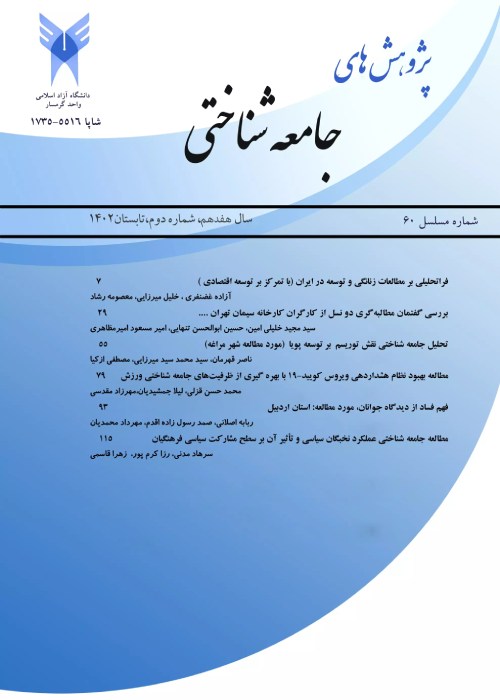A survey of the impacts of social components on social security in Sanandaj city
Author(s):
Abstract:
The aim of this study is to examine the effect of social components on societal security in Sanandaj city. Qualitative (depth interview) and quantitative (self-administered questionnaire) methods have been utilized for data gathering. The population of this study was all youths over 18 years old residing in Sanandaj, sample size for qualitative method based on theoretical sampling was 60 people and for quantitative method was 382 that for more confidence were increased to 400 people. Sampling method was multi-stage cluster sampling. A combination of Copenhagen school and Mitar`s theory has been used for theoretical framework. The results show that the correlation between social norms and societal security was in average and direct (0.456), for marginal inhabitants women expressed that street bothering was the major factor of security threatening. The significant relationship exists between gender and street bothering at % 99 levels. Components in social domain have a negative effect on social security for the second group of marginal inhabitants (contrabandists).women in marginal areas expressed that social component were the major threatening sources of their security but for men(good contrabandists) of this area the threatening source was economical rather than social. Home and shop stealing was the major source of threatening for the first group of central inhabitants (businessmen).40 percent of respondents expressed that they have a great fear if they leave their home for a long time. For formal and cultural group (second group of central area) the major threatening factor was in other domains (economical, cultural, etc) rather than social domain. The results of logistic regression analysis show that, in general, social components have a great effect on social security. Basing on logistic analysis, social crimes, gender, family size, education, law function, and social norms had profound effects on social security respectively and they have classified respondents about 82.5 percent correctly.
Language:
Persian
Published:
Journal of Sociological Researches, Volume:3 Issue: 3, 2009
Page:
155
magiran.com/p871766
دانلود و مطالعه متن این مقاله با یکی از روشهای زیر امکان پذیر است:
اشتراک شخصی
با عضویت و پرداخت آنلاین حق اشتراک یکساله به مبلغ 1,390,000ريال میتوانید 70 عنوان مطلب دانلود کنید!
اشتراک سازمانی
به کتابخانه دانشگاه یا محل کار خود پیشنهاد کنید تا اشتراک سازمانی این پایگاه را برای دسترسی نامحدود همه کاربران به متن مطالب تهیه نمایند!
توجه!
- حق عضویت دریافتی صرف حمایت از نشریات عضو و نگهداری، تکمیل و توسعه مگیران میشود.
- پرداخت حق اشتراک و دانلود مقالات اجازه بازنشر آن در سایر رسانههای چاپی و دیجیتال را به کاربر نمیدهد.
In order to view content subscription is required
Personal subscription
Subscribe magiran.com for 70 € euros via PayPal and download 70 articles during a year.
Organization subscription
Please contact us to subscribe your university or library for unlimited access!


